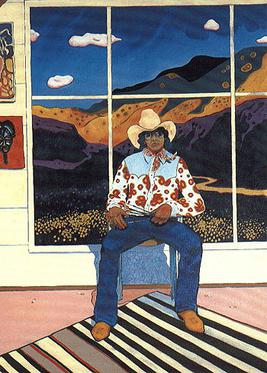T. C. Cannon facts for kids
Quick facts for kids
T. C. Cannon
|
|
|---|---|

Self Portrait in the Studio,
1975, oil painting, 72 × 52 in., private collection |
|
| Born |
Tommy Wayne Cannon
September 27, 1946 |
| Died | May 8, 1978 (aged 31) |
| Nationality | Kiowa Indian Tribe of Oklahoma (American) |
| Education | Institute of American Indian Arts; San Francisco Art Institute; Central State University |
| Known for | painting, printmaking |
| Movement | Native American art |
Tommy Wayne Cannon (born September 27, 1946 – died May 8, 1978) was an important Native American artist. He was a member of the Kiowa Tribe. He also had Caddo and French family roots. People knew him best as T. C. Cannon.
Contents
Growing Up: T.C. Cannon's Early Life
Tommy Wayne Cannon grew up in Oklahoma. His parents were Walter Cannon (Kiowa) and Minnie Ahdunko Cannon (Caddo). His Kiowa name was Pai-doung-a-day. This name means "One Who Stands in the Sun."
He learned about art from the Kiowa Six. This was a group of famous Native American painters. They helped create a style called Southern Plains Flatstyle painting. Young T.C. Cannon was especially inspired by Stephen Mopope and Lee Tsatoke Sr.
Where Did T.C. Cannon Study Art?
In 1964, T.C. Cannon went to the Institute of American Indian Arts (IAIA). This school is in Santa Fe. There, he studied painting with Fritz Scholder. After graduating from IAIA, he went to the San Francisco Art Institute. However, he left after only two months.
T.C. Cannon's Time in the Army
After leaving art school, Cannon joined the army. He served as a paratrooper in the 101st Airborne Division. He was sent to Vietnam from 1967 to 1968. During the Tet Offensive, he showed great bravery. He earned two Bronze Star Medals. He was also honored by being inducted into the Black Leggings Society. This is a special society for Kiowa warriors.
T.C. Cannon's Amazing Art Career
Even while in Vietnam, Cannon's art career began to take off. Rosemary Ellison, a museum curator, included his work in a big art show. This show was called Contemporary Southern Plains Indian Art.
In 1972, Cannon had a special art show with Fritz Scholder. It was at the Smithsonian Institution's National Museum of American Art. The show was named Two American Painters. In their art, Cannon and Scholder challenged old ideas about Native Americans. They used humor and unexpected styles. This opened up new ways of thinking in modern art.
Cannon created many artworks over the next six years. He was getting ready for his first solo art show. It was planned for October 1978 in New York. Sadly, he passed away in a car accident before the show.
What Happened to T.C. Cannon's First Solo Show?
After a delay, his special show opened on December 10, 1979. It was called T.C. Cannon: A Memorial Exhibition. The show featured 50 of his artworks. It traveled to many places. These included the Heard Museum and the New Mexico Museum of Art.
Art for Public Spaces: T.C. Cannon's Commissions
T.C. Cannon also painted large murals. Murals are big paintings on walls. He created murals at the United Indians of All Tribes Foundation. He also painted at the Daybreak Star Cultural Center in Seattle, Washington. Another mural was for the Santa Fe Opera Guild.
Honors and Recognition for T.C. Cannon
Cannon was an artist-in-residence at several places. This means he was invited to live and create art there. He worked at Dartmouth College and Colorado State University. He also worked with the United States National Park Service. In 1988, after his death, he was honored. He was added to the National Hall of Fame for Famous American Indians in Anadarko.
Images for kids


